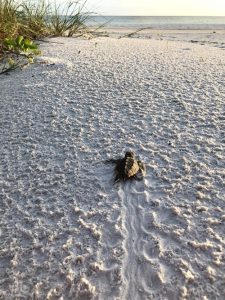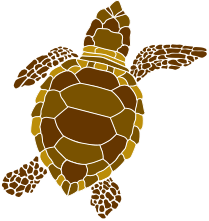By Gary Mooney
Fort Myers Beach Nests Down; Hatchlings Up

“In 2016, our four sea turtle nesting areas had 270 total nests,” reported Eve Haverfield, the founder of Turtle Time, Inc., a non-profit established in 1989 for the benefit of marine turtles on Big Hickory Island, and Bonita, Bunche, and Fort Myers Beaches. “This year, when the season concluded on October 31, we had 297! We compare 2018 to 2016 because Loggerhead turtles nest every other year.”
While Big Hickory Island and Bonita Beach exceeded 2016, Bunche was down one, with Fort Myers Beach significantly lower. “Bonita increased from 160 nests to 203, Big Hickory from 16 to 25, and Bunche Beach went from 2 down to 1, though that is still rare and exciting,” Eve stated. “Fort Myers Beach, however, declined from 92 to 68 nests. What basically happened it that more nests shifted to Bonita Beach, with a few more on Big Hickory Island. The news is not all bad for Fort Myers Beach, however, as we witnessed a significant increase in the successful hatchling rate, from 54% in 2016 to 73% this year, so even though we had fewer nests, they produced more hatchlings!”
What makes that hatchling rate vitally important is the tremendous number of 2018 juvenile and adult nesting sea turtle deaths from the massive Red Tide outbreak that environmentally and economically decimated Fort Myers Beach. “We documented 103 dead adults and juveniles on the island this past season,” Eve emotionally related. “While the increase in hatchlings entering the water is certainly a hopeful sign for the future, keep in mind that only 1 to 4 out of every 1,000 survive to adulthood. They do not reach maturity for 30 to 50 years, so when those turtles survive those long odds, only to die needlessly, that is devastating.”
Turtles & Red Tide
Eve stated the Number One Question she received all summer was what effect the Red Tide was having on the turtle hatchlings. “Thank goodness, the minute they hatch, they head straight for the Gulf, off and running on their journey, swimming nonstop for the first 24 hours or so, covering about one-mile-an-hour, so they get approximately 25 miles offshore before stopping, getting into the Gulf of Mexico current that sweeps them away from the toxic waters. On top of that, they have a yoke of food that sustains them for several days, so they do not drink or eat anything until then, so they escaped the polluted water virtually unharmed, so hopefully they will balance everything out and recoup the losses in another 30 to 50 years. What kills the adults and juveniles is they consume the invertebrates, crabs and vegetation that are full of the Karenia brevis (Red Tide) toxin.”
This uncertain future means it is more important than ever to maintain conditions that protect nesting sea turtles on Fort Myers Beach. “This is the time to strengthen our codes and institute measures to prevent any more stress on our water quality conditions,” explained Eve. “Remember all the codes that protect nesting sea turtles are not at the expense of compromising human safety, like Amber LED lights that are turtle friendly while providing plenty of illumination for people. We had 9 disoriented nests this season, and that is 9 too many, as we lost hundreds of hatchlings when they marched to the wrong light source and away from the Gulf. Sea turtles are the canary in the ocean, so to speak, with that so obvious this year, as they washed up on the sand dying, proving to us the water was toxic. We must protect and strengthen the Endangered Species Act as well as local Ordinances, because by protecting sea turtles we protect ourselves.”
All-in-all, Eve judged the 2018 Fort Myers Beach nesting season a mixed bag. “While hatchling percentages are a success, nesting numbers were down. It was at times very trying and depressing when we would encounter all the dead sea turtles as a result of the Karenia Brevis toxins, particularly when we found Greens or the Kemp’s Ridleys that are the most endangered species washed up dead or near-dead. Those were not the happiest times and pretty heartbreaking, so it would be myopic not to help the sea turtles now more than ever.”
Eye on 2019
With the 2018 season in the rearview mirror, Eve already has her eye on 2019. “If we could get another record-setting year like we had in 2017, minus an ‘Irma,’ it could be pretty fun! However, due to all the turtle deaths this year, it is only speculation how those numbers will affect everything next year. Sanibel recovered dead sea turtles by the hundreds this past season, with all those adult and juvenile turtle losses just mind-boggling, and that was not just true here in Southwest Florida but all along the State’s coastlines. On a lighter note, we will launch the new Turtle Time website in the next week or so, and we encourage everyone to check it out at turtletime.org. It is really cool and I love it!”
Eve thanks the many residents, visitors, and beach businesses for their efforts to protect the nesting sea turtles and hatchlings in 2018. “The Lani Kai Resort, for instance, hosted a ‘Turtle Time’ fundraiser, so I am very grateful that they were so positively involved, along with many other businesses that went above-&-beyond to help sea turtles. Thank you as well to the Town of Fort Myers Beach, its Public Works Department, and in particular Austin Gilchrist for their help, especially in retrieving dead sea turtles and getting us through this crisis. Thank you so much to all of our ‘Turtle Time’ volunteers, who got up so early every morning. And thank you to ‘The Island Sand Paper’ because you are the media outlet who assisted the most in getting out our message! Remember that we depend on the oceans for our very survival, and what happened to the sea turtles in 2018 should be our ‘Wake Up Call!’”
Source: FortMyersBeach.news
